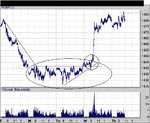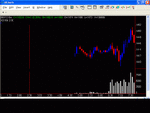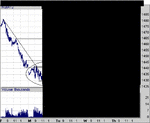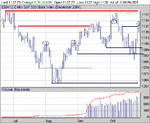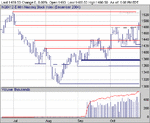sulong said:
Except perhaps, it looks to me like NQ closed on support, and ES closed under resistance zone..@ 1127 - 1130. Which only supports what you said.
Well, not really. Just because price moved thru NQ R doesn't mean that R failed. R doesn't become S until price clears it and tests it from the other side. Price could easily drop back through, and given the R situation in ES, that's not an unreasonable possibility.
In any case, there are a few things I don't want to gloss over here regarding the patterns of each of these. Note, first, where the NQ finds S at the end of September. Now look at ES. It seems to find S in midair, failing to return to that 1094 level. However, if you look at those two congestion zones below those swing points you have circled and think of these areas -- and not just a line -- as support, the dynamic makes a little more sense. It also gives the trader more flexibility. If he then focuses on where the trading activity picks up, he's more likely to detect the turning point than if he were to wait for some line to be hit.
Next comes early October. The ES finds R higher in its range than the NQ, but the NQ finds its own R in its own chart at the same time, which is the point I was trying to make earlier. Similarly, the ES finds S on Monday and Tuesday way back at the early September level, and the NQ finds S at the same time but at a level which, though higher, represents S in its own chart, at 1420 (no, it doesn't reach 1420 exactly, but it does find S within that zone which formed two weeks ago between 1420 and 1440-ish.
Note also that the NQ "ranges" are much more rectangular, which makes S/R easier to see. However, if you also circle the swing points, as you've done, you see that each is finding S or R at the same time, though not in the same ways.
I may have made this less clear rather than more clear, but this is the best I can do for now. What matters to me is that they're both at important R. It's possible that they could both break through and go to the next level, which would be 32 (+/-) pts for the NQ and 13 (+/-) for the ES, or about 2.5:1, which is the normal ratio. Therefore, unless we just rest here for two or three days, we'll have to be open to moves in either direction.

